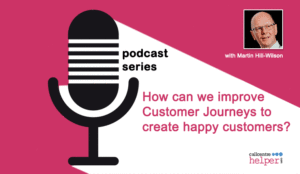Laura Bassett at NICE inContact discusses the role of the contact centre in creating a connected, digital experience.
The digital customer journey is very different from a physical shopping experience, yet it is very much the same. With the ever-changing needs of the consumer, it can be difficult for businesses to keep up and ensure that customers have a seamless buying journey from start to finish and beyond.
Of course, to understand this journey, you have to know what it is, how it works, and what role your brand plays in delivering ideal experiences every step of the way. If that sounds like a lot, don’t worry – it’s easier than you might think.
Yes, you too can take a proactive approach to customer service and ensure that every journey reaches the appropriate destination.
The Developing Face of Customer Contact
People talk about the customer journey and how important it is to the success of a brand, but few understand the nuts and bolts of how a digital experience is different from traditional sales and service methods.
The goal isn’t to eliminate the need for contact but to integrate every contact as part of the customer’s personal journey and ensure they have all the tools they need at their disposal, including your team of support personnel.
Good cloud contact centre platforms gives you the tools to create and be part of that journey, but it’s up to you to learn how.
Before digging into the details, though, let’s talk a little more about the customer journey and how the digital user experience shapes your business decisions, from marketing to sales and beyond.
Defining the Customer Journey
The customer journey is the sum of the experiences that a user has when interacting with your brand or business. Rather than looking at static actions separately, the journey combines the experience from the perspective of the customer and documents it as a whole, so you can clearly see what’s going on.
Seeing the steps that customers take can help you improve your online presence, customer service, website design, and more. In the digital world, the customer journey is like that of a physical consumer, but with a few noticeable changes.
Because of the ease of access, people shopping online will typically have a lot of back and forth between the information and decision stages. They may add something to their cart right away but then go back and forth on research, comparison shopping, and checking out your brand for reputation and other factors.
A chore like buying a dishwasher – which used to be an event that included visiting multiple stores, looking in newspaper ads, and talking to various sales people – can now be done online in just a matter of hours. I just did this, so I know! Here’s how it played out – from the customer perspective.
- Step 1: Current dishwasher breaks – Boooo!
- Step 2: Call repairman found through neighbourhood social page (yay digital!!) – cannot be repaired.
- Step 3: Go online, research, find new dishwasher, pricing, who will install, earliest delivery (I hate washing dishes!) – check out 4-5 retailers, narrow to top 2.
- Step 4: Determine preferred retailer – then discover cannot click “deliver and install” option. Hmmmm
- Step 5: Chat online with preferred retailer, agent could not answer question, did not offer to view my in-process order. Referred me to call an 800#.
- Step 6: Don’t even pick up the phone, go to 2nd retailer, $50 more, same product, same delivery timeframe, will install.
- Step 7: Buy from 2nd retailer, at a higher price.
- Step 8: Smile, get back to work!
Note a few key points here: First, I never set foot in a store. I did lots of back and forth on various pages for decisions, used Google to compare models, looked at ratings from previous consumers and compared different brands and models – before I even got to a vendor-specific search.
And, my preferred retailer lost my business due to lack of online options, and never offered to call me directly to solve my issue – that could have made all the difference.
Had I been in their store I likely would have purchased from them – I have in the past. They are reputable and, in my opinion, trustworthy.
Buyers like myself are taking advantage of this freedom and accessibility of information. And if businesses aren’t prepared, they lose.
Understanding and documenting this customer journey specific to your business produces a customer journey map that you can reference, and improve, based on the experience you want to deliver. Walk in your customer’s shoes – it does wonders!
Keep in mind though, the journey isn’t always a sales transaction. It could be an online experience, customer support, a professional service, or any other interaction with your brand.
Of course, the more touchpoints you have, the more complex the customer journey map becomes. At the same time, that makes it that much more valuable of an experience and drives better results.
Not All Who Wander Are Lost – but Some Are
The biggest hurdle for people trying to understand the customer journey is that they want it to be linear, and let’s be honest, it rarely is. Think of the journey more like a quest in the digital realm; people may arrive at the decision stage before they go through the information stage.
How often have you purchased something on a whim doing no more than clicking “add to cart”?
The journey may take a wandering path back and forth between action, decision, information, and follow-through, as people try to navigate their way through the digital world and make their decisions.
Without an integrated solution, you aren’t able to be aware of all of this wandering nor are you able to capitalize on that insight to help them find their way.
Customer Journey Maps Point the Way
If you want to get a top-down view of the journey your customers take from the moment they come in contact with your business, a customer journey map is the way.
This map, much like the typical journey, shows a collection of touchpoints that the customer makes along the way while considering, and hopefully eventually deciding to do business with you.
The customer journey map allows you to identify information across the journey such as:
- Actions: What customers are doing at every stage of the journey
- Motivations: What is motivating people to start at a certain point or continue in their journey
- Barriers: Potential complications or roadblocks on the customer journey, such as cost, processes, UX issues, lack of information, and more
- Questions: Any uncertainties that customers have along the way or at various touchpoints throughout the journey
Identifying these variables is the first step to helping improve the journey for all of your customers. If you know what they’re doing, why they’re doing it, and where they need assistance, you can take a proactive approach to make changes and give them a better experience before they even have to ask.
Customer Journey Maps Provide Insights
When you have a better understanding of the customer journey, you can gain many valuable insights. This can impact your business in several ways:
- Better fundamental understanding of your customers and their needs, wants, and expectations. When you see where people are going and how they’re going there, you can create a better support system.
- Help identify operational issues and course-correct as necessary. This isn’t just about improving things for the customer. The customer can also show you where you can make other improvements for your brand and for your employees who service those customers – at any touchpoint – on the digital journey, in the store, or on the phone.
- Align the entire organization along the same customer experience journey. When your organization is aligned, it is easy to provide the best digital journey for every customer based on their specific demands or desires.
- Understand customer effort. This is a valuable metric that can be an indicator of customer satisfaction and the likelihood of retention, helping drive business goals around those elements.
NOTE: Customer effort is a new term for some so here’s a quick definition. It refers to how much effort a customer has to put in to do business with your brand.
In your analytics, it’s known as the Customer Effort Score or CES, and it typically ranks on a scale of one to 5, 10 or even 7, with each associated with a level ranging from easy to hard. This is what will often determine, overall, how likely a customer is to continue doing business with your brand.
Omnichannel vs. Fragmented Journeys
A fragmented customer journey is a broken journey. It is a sure sign that something in your digital experience isn’t working as it should, causing customers to jump around to complete their journey. To be clear, this is not what we’re referring to when we talk about how the digital journey is non-linear.
What we’re referring to is the omnichannel experience. Users may start their interaction on a chatbot, or maybe on the web, then upgrade to a live chat with an agent before eventually ending up on the phone with that same call centre representative.
This could all take place throughout the various steps of the journey (awareness, education, discovery, decision-making, etc.).
Today’s customer journey should be very omnichannel focused. Essentially, users are going to take whatever route is necessary to get to the information, products, or services that they need.
Because the Internet makes it so easy, it makes sense for them to do so. Your job as a brand is to make sure that the tools and resources are in place so that they can make the journey in any way they see fit.
That’s what having an omnichannel routing solution is all about – making sure your customers are intelligently routed on their buying journey to get the exact solution that they need, even if that solution changes on a dime.
Omnichannel cloud contact centre applications should also enhance your agility by allowing you to deploy agents anywhere and in any capacity, providing maximum flexibility in your operations.
You can implement changes and updates in a matter of hours, rather than waiting days or even months for new integrations. And, you can manage and train agents based on the complete array of channels offered and report, gather feedback, and analyse on every interaction, regardless of channel, in a single, unified tool. Your customers want to get the best experience.
You want to give them the best experience, regardless of what that means for their buying journey. Part of that comes in being prepared with agile, omnichannel solutions.
Going Beyond Omnichannel Interactions
What else can your brand do to create the connected experience that today’s consumers demand? Integrating CXone into your day-to-day operations is one option. But there are other actions that can be layered in to ensure a more robust presence in the marketplace.
Be Proactive, Not Reactive
Call centres and customer service departments that are dedicated only to resolving problems after the fact are practically archaic at this point.
In fact, if all your customer experience team is doing is reacting to problems, you might cost the company thousands of dollars in potential business by not staying ahead of the consumer.
A proactive contact centre will implement a variety of contact solutions, assess and outline potential hurdles, resolve them before they become issues, and ensure that customers have a connected, positive experience, no matter where their journey begins or ends.
A reactive contact centre will stand by and await customer calls, complaints, issues with user experience, and other “problems” that need to be resolved.
While this feedback is necessary and helpful, taking a proactive approach can eliminate several of the problems from the start and practically eliminate the need for a reactive approach.
Most companies have realized that customer satisfaction is the driving indicator of success, but too many campaigns focus on specific touchpoints or limited channels, which results in limited progress.
This only allows your brand to keep pace with the changes, and you need to get ahead of the game.
To achieve that, we need to think a bigger. To really improve customer satisfaction from the start, it’s time to transform the entire customer experience.
Transform the Customer Experience
Getting a top-down view of the customer experience can prove difficult. So many initiatives end up falling short. But why? Most commonly we don’t get down to a granular enough view of their customers’ behaviours.
Why do they go to the competition? Why don’t they click purchase? Or potentially don’t set a clear strategy that includes dynamic engagement and tracking metrics across all channels and touchpoints – its just as important to understand behaviours on WhatsApp, on the web, or in the store as it is on the phone!
There are many potential hurdles in the digital customer journey that are critical to understand.
To be successful, brands need to:
- Insert themselves into as many phases of the customer journey as possible.
- Key into the differences in digital devices (and how people use them) and consider those variations and their impact on buying decisions. This is where mobile-first design becomes critical.
- Produce several types of content across multiple phases of the journey to ensure that customers have preferred ways to get information.
- Provide a contact centre experience that supports the customer from the start of their journey and is available at every turn.
Omnichannel Support Covers Every Interaction
If you are going to create a truly connected experience, make sure you care for every channel, medium, and need that could arise. If you anticipate your customers’ needs, they will notice. Especially in today’s instant gratification society, people want (ok, expect) to be taken care of without having to ask.
The main ingredient here is the collection and connection of all the various fragments of customer interaction that happen along the buying journey. This collection will allow you to tie everything together for a truly connected digital experience from start to finish.
Here are some of the biggest perks of having a robust omnichannel approach to your contact centre and customer support.
More Ways to Engage
People love options. They want things to be easy and available, and they want it on their terms now more than ever. Having true omnichannel support ensures your customers can engage with your brand in any format and at any touchpoint, no matter what they need.
Giving your audience the genuine feeling that you are always there for them is the best thing that any modern brand can do.
A Seamless Journey
Today’s consumer is spoiled by advances in technology. They know what they want, and after years of shopping in the physical world, they have a certain level of expectation about not just the products and services that they get, but the support that they get along the way.
Integrating an omnichannel approach will allow you to create that seamless experience, providing a smooth journey. Plus, when the road gets rough, help is easy to find.
Better Retention
When people feel like they’re working with a truly accountable, supportive brand, they come back for more. Although some people will shop anywhere without so much as a second thought, plenty of people put a lot of consideration into their choices, and they remember good experiences, and more so, good service.
If you don’t have robust, personalized support available throughout the entire customer journey, people might complete their journey but not bother coming back. When people feel supported by a brand, they feel loyalty toward it. It’s that simple.
Improved Data Quality
For your business, omnichannel contact centre solutions do more than just improve things for the customer. They also improve your ability to monitor the customer, the overall experience, and the various touchpoints in the journey.
You can collect more accurate and useful information about your potential buyers, their problems, growing pains, and more. And, you can use that information to proactively solve problems or enhance the journey experience.
When people feel like they can reach out to you, they’ll give you more information – more valuable information. This helps with future growth.
Reinforced Trust
When you have support available in several formats, or in this case, when you offer support in the capacity where your customer might need it, you’re holding your brand accountable to a higher standard.
This reinforces the trust of your customers in your brand. It also reinforces your credibility with third-party sources, such as search engines, business critics, third-party reviewers, and more.
Not offering robust support could be perceived as not caring about the customer, or worse, as having something to hide – and we all really want to help our customers in the best way we can, of course! That’s where a well-planned omnichannel support system proves your case.
Improved Satisfaction
And now, we have come full circle. When you implement a robust omnichannel contact centre solution you improve overall customer satisfaction.
If you’ve been paying attention in the world of modern business, that satisfaction is the single biggest indicator of your success as a brand. There are many reports that show it being directly proportional to growth and stock value.
Thus, if you want to build a brand that not only delivers the ideal customer journey but also succeeds overall, you need to have the right tools in place, including support across all channels and mediums.
Connecting the Dots
While the modern customer journey might seem fragmented, it’s just the way that people do things in the digital world. The digital customer journey is more of a collection of experiences and touchpoints, sometimes with gaps across time, rolled into a single transaction or encounter with a brand.
When you have all these touchpoints, but the customer journey looks more like a scribble than a map, it’s hard to follow.

Laura Bassett
Fortunately, when you’ve also got a strong contact centre solution in place, it will be easy to connect all those dots and get an actual picture of the digital customer journey from start to finish – and every step in between.
That kind of top-down look at the customer journey not only helps improve your brand’s digital customer service, but it also helps you see where you can drive engagement, creating more opportunities to enhance the user’s experience at each contact point.
This blog post has been re-published by kind permission of NICE CXone – View the Original Article
For more information about NICE CXone - visit the NICE CXone Website
Call Centre Helper is not responsible for the content of these guest blog posts. The opinions expressed in this article are those of the author, and do not necessarily reflect those of Call Centre Helper.
Author: NICE CXone
Published On: 18th Mar 2021 - Last modified: 12th Jun 2024
Read more about - Guest Blogs, Laura Bassett, NICE CXone






 NICE CXone combines best-in-class Omnichannel Routing, Workforce Engagement, Analytics, Automation and Artificial Intelligence on an Open Cloud Foundation.
NICE CXone combines best-in-class Omnichannel Routing, Workforce Engagement, Analytics, Automation and Artificial Intelligence on an Open Cloud Foundation. 






























